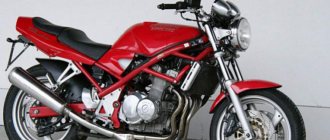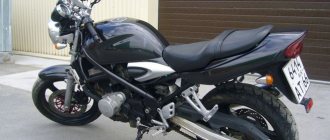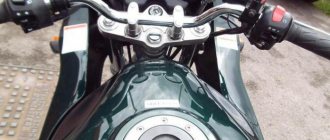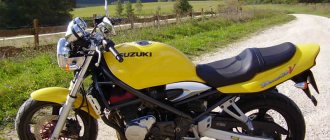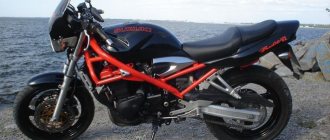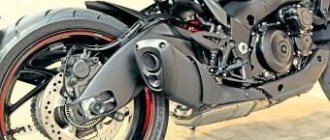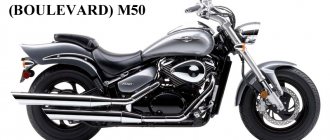- motorcycle model, Suzuki brand
The Suzuki GSX1250FA sports tourer model appeared in 2010 on the basis of the Suzuki GSF1250 Bandit road model, essentially representing one of the Bandit 1250 trim levels. It is noteworthy that the Bandit prefix was not available in all markets - in particular, in Japan the GSX1250FA model was also called the Suzuki Bandit 1250F .
The basis for the Suzuki GSX1250FA was an in-line 4-cylinder liquid-cooled engine with a volume of 1255 cm³ and producing 100 hp. power and 107 Nm of torque. The motor is completely identical to that installed on the Suzuki GSF1250 Bandit.
The Suzuki GSX1250FA model differs from the Suzuki GSF1250 Bandit, first of all, by the presence of a full plastic body kit and an ABS system as standard equipment. In all other respects, these are identical motorcycles.
Features include a steel duplex frame, adjustable suspension in the form of a conventional telescopic fork at the front (adjustable for preload) and a monoshock absorber at the rear (adjustable for preload and rebound), 4-piston disc brakes at the front, 6-speed gearbox, chain drive and 257 kg of curb weight. masses.
2016 was the last year of production of the Suzuki GSX1250FA model and, in general, the entire Suzuki Bandit 1250 series.
Brief history of the model
2010 - start of production and sales. Model: Suzuki GSX1250FA (Bandit 1250F) (Japan, North America, Europe, Oceania). Factory designation: GSX1250FAL0.
2011 - no significant changes. Model: Suzuki GSX1250FA (Bandit 1250F) (Japan, North America, Europe, Oceania). Factory designation: GSX1250FAL1.
2012 - no significant changes. Model: Suzuki GSX1250FA (Bandit 1250F) (Japan, North America, Europe, Oceania). Factory designation: GSX1250FAL2.
2013 - no significant changes. Model: Suzuki GSX1250FA (Bandit 1250F) (Japan, North America, Europe, Oceania). Factory designation: GSX1250FAL3.
2014 - no significant changes. Model: Suzuki GSX1250FA (Bandit 1250F) (Japan, North America, Europe, Oceania). Factory designation: GSX1250FAL4.
2015 - no significant changes. Model: Suzuki GSX1250FA (Bandit 1250F) (Japan, North America, Europe, Oceania). Factory designation: GSX1250FAL5.
2016 is the last year of production. Model: Suzuki GSX1250FA (Bandit 1250F) (Japan, North America, Europe, Oceania). Factory designation: GSX1250FAL6.
Suzuki GSX1250FA (Bandit 1250F) motorcycle review
This is not a motorcycle, this is a real limousine on two wheels!
The city roads of Yoshkar-Ola, and the country roads in some places, frankly speaking, are not so hot. There don’t seem to be any holes, but it’s shaking quite a bit. That's it! Everywhere is smooth! Now I'm on "LIMUBANDITE"!
The front fork and rear monoshock allow you to configure the suspension as you like. The adjustments are, of course, standard: spring preload at the front and rebound travel with preload at the rear. This, I assure you, is quite enough. But it’s not just the suspension that allows you to ride in a thrill without jumping on bumps. BANDIT 1250 - heavy - 257 kg dry weight, and with me, oil (oil, gasoline), etc. so everything will be 380.
Motor is a song! It pulls from idle without gas. In the city I turn on third and drive - it will suit any driving mode. FANTASTIC! Like on Zhenya’s scooter! Gas and brake! The gears are switched on clearly, but a little harshly. The neutral is caught at once. There is a gear engaged indicator on the instrument panel.
“Bandit” rear view mirrors - SUPERRRRR!!! You can see everything and everyone!
On the track it’s even better - everything is smooth and predictable. Need acceleration - please! Immediately and as much as needed! Overtaking a truck - instantly! Wind protection is beyond praise - no chatter. The plastic hood and fairing provide excellent protection, which, of course, has a positive effect on aerodynamics. For my build and height (176 cm, 90 kg), a comfortable speed is 100-120 km/h - after that I begin to feel that the Earth has an atmosphere.
The seat is very comfortable. Direct landing, wide, medium-soft seat, standard remote controls, footrests where I need them - my legs don’t get tired. Comfortable! It's good when you don't have to get used to it. It was as if the motorcycle was made personally for me. The very first hold at 240 km confirmed my feelings.
Brakes with ABS. Some say they are rather weak. For me, that’s just it, they brake normally at any speed.
And the moto also has a trump head light in stock! The visibility is great on a dark night! A clear, even beam of light from edge to edge of the road. Very happy!
The instrument panel is a symbiosis of a dial tachometer and a digital speedometer, odometer, clock, etc. Has a nice backlight. Everything, of course, is regulated and customizable. I figured it out for two days, then I found a manual in Russian - five minutes was enough.
Fuel tank - 19 liters. In the mixed (50% city, 50% highway) cycle, I drove 382 km on the tank and there was still quite a bit of splashing. You can’t dry it - the pump will burn out.
Two more stock features are encouraging. These are hazard warning lights and heated steering wheel grips. The handles heat up perfectly, but only in one mode, I would say, too well. I didn't find anything about heating in the manual.
Bandit is super, I ride a big one myself.
In terms of consumption, of course, this is only when you feel sick. I had something like this when we were pooping around Europe. If there is no autobahn there, then such an expense can be arranged.
As for the seat, nothing gets tired on it. Tested by our own 5th point, over 7000 km in 13 days.
Regarding drying the fuel pump, this is debatable, since it turns off without gasoline. Verified. I took mine apart and wanted to change it, but I got away with cleaning the filter. So, if you start it with gasoline, it simply turns off. Actually, the protection is against a fool and an empty tank.
The wind protection copes well up to 140-150, taking into account the fact that my glass is already higher. But I’m thinking of getting even larger glass for long-distance travel.
My motorcycle
It took me a long time to choose a moto for myself. I haven't reviewed anything. First there was an attempt to buy a HONDA NC700 with an automatic transmission, then a YAMAHA BT1100 BULDOG, and a bunch of other devices... But these were only attempts to buy! But when I saw the SUZUKI GSX1250FA BANDIT, I immediately took it without hesitation - and I didn’t make a mistake with the choice. APPARATUS
Well done! Just handsome! Well, how can you not praise yourself! Motorcycle in “White Mother of Pearl” color, 2012 with a mileage of 14,772 km on the roads of a country that cannot live without the Kuril Islands. It took a long time to get to me. I paid for it in early February, but received it only in August.
Oh well, it was worth the wait, I'm not offended. The previous Japanese owner “worried” about me and installed sliders on the motor to protect the plastic and sliders covering the side covers of the engine crankcase. Thank him very much for this! Also thanks for the very careful operation, which allowed the auction expert to write the phrase “Very nice!” in the final comment. and give 5.5 points for the final grade. The condition of the motorcycle is almost perfect - there are a couple of mistakes: a small crack in the plastic on the left side and a paint chip on the front fender. It seems that the mot was just carelessly leaned somewhere. The first start of the engine took place “at the drop of a hat,” but... led to the replacement of the battery. The key is in the lock in the “From the screw!” position, the tachometer needle merrily ran around in a circle, the clutch, the muffler button. The old battery, in fact, also had enough strength to vigorously turn the starter, but the ABS and fuel pump stopped working. The ABS turned on the yellow light on the instrument panel after about 15 minutes, and the fuel pump seemed to turn off at a speed of just over 60 km/h. Yes, also, all this disgrace was completed with the victorious illumination of the pictogram “Turn out the engine!” (in common parlance “CHECK ENGINE”). Replace the battery and all the problems are gone.
FIRST TRIP
It took place in the company of my charming wife Zhenya on a beautiful sunny day. Our conics look good together... This is not a motorcycle, this is a real limousine on two wheels! The city roads of Yoshkar-Ola, and the country roads in some places, frankly speaking, are not so hot. There don’t seem to be any holes, but it’s shaking quite a bit. That's it! Everywhere is smooth! Now I'm on "LIMUBANDITE"! The front fork and rear monoshock allow you to configure the suspension as you like. The adjustments are, of course, standard: spring preload at the front and rebound travel with preload at the rear. This, I assure you, is quite enough. But it’s not just the suspension that allows you to ride in a thrill without jumping on bumps. BANDIT 1250 - heavy - 257 kg dry weight, and with me, oil (oil, gasoline), etc. so everything will be 380. Motor is a song! It pulls from idle without gas. In the city I turn on third and drive - it will suit any driving mode. FANTASTIC! Like on Zhenya’s scooter! Gas and brake! The gears are switched on clearly, but a little harshly. The neutral is caught at once. There is a gear engaged indicator on the instrument panel. “Bandit” rear view mirrors - SUPERRRRR!!! You can see everything and everyone! On the track it’s even better - everything is smooth and predictable. Need acceleration - please! Immediately and as much as needed! Overtaking a truck - instantly! Wind protection is beyond praise - no chatter. The plastic hood and fairing provide excellent protection, which, of course, has a positive effect on aerodynamics. For my build and height (176 cm, 90 kg), a comfortable speed is 100-120 km/h - after that I begin to feel that the Earth has an atmosphere. The seat is very comfortable. Direct landing, wide, medium-soft seat, standard remote controls, footrests where I need them - my legs don’t get tired. Comfortable! It's good when you don't have to get used to it. It was as if the motorcycle was made personally for me. The very first hold at 240 km confirmed my feelings. Brakes with ABS. Some say they are rather weak. For me, that’s just it, they brake normally at any speed. And the moto also has a trump head light in stock! The visibility is great on a dark night! A clear, even beam of light from edge to edge of the road. Very happy! The instrument panel is a symbiosis of a dial tachometer and a digital speedometer, odometer, clock, etc. Has a nice backlight. Everything, of course, is regulated and customizable. I figured it out for two days, then I found a manual in Russian - five minutes was enough.
Fuel tank - 19 liters. In the mixed (50% city, 50% highway) cycle, I drove 382 km on the tank and there was still quite a bit of splashing. You can’t dry it - the pump will burn out. Two more stock features are encouraging. These are hazard warning lights and heated steering wheel grips. The handles heat up perfectly, but only in one mode, I would say, too well. I didn't find anything about heating in the manual. A couple of photos while walking... Today the motorcycle is registered and is being successfully operated. Good luck to all of us always and everywhere!
2011 – Kawasaki Ninja 1000 vs. Suzuki GSX1250FA and Yamaha FZ1
Three of the best sportbikes you can ride without cramped legs or sore wrists.
What started out as a simple duel between the Kawasaki Ninja 1000 and the 2011 Yamaha FZ1 turned into a truly exciting showdown when the 2011 Suzuki GSX1250FA entered the fray. Newcomer Suzuki pushed the boundaries of the first two bikes' judging criteria, helping to highlight the flaws and shortcomings that balanced them out. advantages.
Introduced this year, the Kawasaki Ninja 1000 and Suzuki GSX1250FA are the latest models in the trio. The updated Suzuki Bandit now features a full fairing and ABS as standard, which is more typical for the sport-touring class than for a sportbike.
The Ninja has more sporty features and a powerful four-cylinder Z1000 engine, which, however, does not guarantee absolute superiority over other rivals. Each of our test riders had their own opinion on why the motorcycle they liked should take the top spot. The renamed Bandit Suzuki GSX and the rather old (since 2006) Yamaha FZ1 have an advantage in some details over the Ninja, whose developers probably forgot to implement something that every liter sportbike simply must have.
Where exactly the Ninja Z1000 has the upper hand over the Yamaha is the engine, which is even more powerful. The Kawasaki six-speed had me on the Yamaha counting the seconds until the four-cylinder FZ1 revs. At some point the R1 engine finally reached the peak of its power and acceleration was impressive, but by this time the Z1000 was already a long way off. The FZ1 itself is very fast, but compared to the new Ninja, it feels a little sluggish until it accelerates, of course.
“A motorcycle engine is a key aspect of fast, dynamic riding and in this regard the Ninja engine is as good as ever,” said one rider named Duke. It easily outperforms the Yamaha at low revs, and its short gears have always been a standout feature. Kawi will win any race, I'm sure."
The GSX1250FA, with its 98 Nm of torque at 3500 rpm, wins over the Ninja, which has 97 Nm at 7800 rpm. But the Suzuki's curb weight is 257.2kg, making it almost 29kg heavier than the Kawasaki (228kg) and 36.3kg heavier than the FZ1 (220.9kg). With a torque band that starts at 92.1Nm at 2700rpm and rises all the way to 6800rpm, the GSX is undoubtedly the leader in this area among our three bikes. But where the Suzuki clearly falls short is horsepower output: 92.6 hp at 8,800 rpm, while the Ninja's 121.1 hp at 10,100 rpm and the FZ's 125.1 hp at 11300 rpm.
To say that Kawasaki has a great engine is an understatement. The new Ninja 1000 has the perfect combination of sportbike performance that allows it to be used in urban environments. According to leading sports publications: “The Ninja 1000 has the most outstanding sportbike look possible. Kawasaki has developed and produced a powerful engine that can be used in the city every day. This bike has the most low- and mid-range torque of any sportbike we've ridden."
Considering the Suzuki's 1255cc engine capacity (79.0 x 64.0mm bore and stroke), horsepower numbers below 100 are somewhat disappointing, but well masked by phenomenal low-end torque.
The Ninja and FZ1 share the same 77.0mm piston bore, but the Kawi's engine is slightly larger (1043 vs. 998cc) and also has a higher compression ratio (11.8:1 vs. 11.5:1). In combination with different camshaft profiles, this explains the difference in power characteristics. If you prefer a more track-oriented sportbike, the FZ1 is your choice, but for more casual riding, the Ninja or GSX is preferable.
In terms of riding position and distance from the seat to the pegs, it's hard to tell the difference - all three bikes can confidently score gold stars in the comfort department. But for long and long trips, we would still choose Suzuki.
“The Suzuki 1250FA is a great sport tourer,” notes Boomer. This is the most comfortable motorcycle in the test, and I would say, in general, of motorcycles of this type. What’s also great is that the bike handles bumps and bumps on the road very well.”
Ergonomics and controls
Suzuki and Yamaha lose out to Kawasaki in gas tank design. The Ninja's tank is flat and comfortable, conveying a sense of control over the bike, while the FZ1's tank is large, and the GSX's has an awkward protrusion where it mounts to the frame.
“In terms of comfort, the difference between the Kawasaki Ninja Z1000 and the FZ1 is not very noticeable,” notes tester Kevin. The Yamaha's seat feels a little firmer, the handlebar position on both is very motocross-like, and the vibration damping seems fairly acceptable on both the Ninja and FZ1."
Additional comfort on the Kawasaki is provided by a windshield that has three manual adjustment positions. In the lower position, the best aerodynamic characteristics are achieved, while increasing the force of the wind flow on the driver, which is no less important on hot and stuffy days. The high position accordingly reduces exposure to cold air. My height is 180 cm, and with the glass in the lower position I felt the impact of incoming air currents on my chest, and with the glass in the upper position - in the area of the collarbones, and surprisingly - no effects of turbulence!
The Yamaha windshield is certainly functional, but here the wind flow is controlled by the rise and fall of your body. In terms of wind protection, the Fizzer's functionality is quite modest, falling between its class and being a naked streetfighter. But full wind protection gave a new look to the Suzuki Bandit model, the body of which, although it reliably sheltered the lower part of the body from the wind, was unlikely to receive any award for style.
Yamaha and Suzuki are equipped with a centerstand, which will appeal to motorcyclists who like to maintain their machines themselves, while Kawasaki lacks this, which may be due to the desire to reduce weight (Yamaha weighs about 221 kg, Kawasaki 228.1 kg), or maybe due to ground clearance In any case, a motorcycle equipped with a centerstand can easily be maintained by one person, which would be quite difficult to do without it.
Additionally, the FZ1 has fairly easy access to the engine, while the Ninja and GSX have most of the body kit's plastic parts that must be removed for even the most basic servicing. But the presence of these same body kit parts in the Ninja and GSX provides quite significant protection for the rider in rainy and cold weather. Of course, those who love open-engined motorcycles will prefer the shape and lines of the FZ1 over the plastic-laden Suzuki. But the most aggressive look of all three is Ninja.
In terms of handling, all three bikes performed well despite their weight, and cornering performance was fairly neutral. Considering the amount of fuel (about 19 liters or 13.6 kg) placed at the top of the frame, I personally expected them to be much heavier to handle. But of all three, the GSX still seemed a little heavier to some testers.
“The FA is a little longer and heavier than the rest of the bikes,” says Giardinelli, “it won’t turn as fast as other bikes, but it has a stable underpinnings that Suzuki have done a good job with.”
The Ninja has excellent steering response and excellent directional control, but we did notice a small flaw: when cornering, you need to turn the steering wheel a little to maintain the desired turning arc. This was especially noticeable after 4,000 km of our rather severe testing, and replacing the base Bridgestone BT-016s tires only slightly corrected the situation.
The FZ1 was hailed as the sportiest, but almost everyone was annoyed by its overly responsive throttle response. Yamaha has updated the ECU several times and it works much better than before, but some issues still remain. “The neat, smooth, controlled fuel management of the Yamaha's ECU makes it a challenge to tackle difficult sections of the trail,” Giardinelli observes.
At first glance, neither bike seemed to have a braking advantage, but the FZ1 has dual 320mm discs and four-piston calipers up front, which still provide slightly better stopping feel than the 300mm calipers. Kawasaki's dual front disc brakes with four-piston radial-mount calipers. Considering that the Suzuki weighs more than the rest, its brakes coped with their task no worse than its rivals, and it is worth noting that this is the only motorcycle of the comparison equipped with ABS.
Unlike the FZ1, the Ninja's 41mm inverted forks are pre-set to sport mode, although both bikes have fully adjustable forks, allowing anyone to tweak them to suit their preferences. At the rear, both the FZ1 and Ninja feature a preload- and rebound-adjustable shock absorber.
The GSX's weight sometimes punches through its suspension, but the preload-adjustable 43mm fork and rear shock (which has preload and rebound adjustment) are still up to the task in moderately aggressive conditions.
“I expected the 1250 to live up to its price tag, but it's definitely not at the top of the podium,” Smith notes of the Suzuki. On the way home I felt that the suspension was not as good as I thought."
In addition to the aforementioned ABS and centerstand, the GSX is equipped with a gear position indicator, an adjustable clutch lever (all three bikes have an adjustable front brake lever) and a helmet mount. The FZ has a centerstand and side rails, but no helmet mount, while the Ninja Z1000 only has side rails.
“The Kawasaki Ninja is a great bike, it seems to have everything in place for the rider's comfort, so the lack of a helmet mount or at least hooks is a glaring omission, as it is great for both casual commuting and sports touring.” , notes the picky Duke.
The most comfortable passenger seating was found on the Suzuki. Its seat is quite low and has the best combination of comfort and support, providing neutral-upright ergonomics. The Kawasaki has a slightly leaner stance and is more comfortable to hold onto the handles during, for example, aggressive braking.
For those who love to travel and need luggage, Suzuki offers optional hard saddlebags and a 37-liter overhead storage bin. Yamaha offers top drawers with different volumes - 40, 45 and 50 liters. The Kawasaki can be equipped with 35 liter lockable hard bags.
Prices and Summary
The prices of these three sportbikes are quite an interesting aspect. The GSX1250FA is equipped with ABS, but the $11,599 asking price still seems a bit steep for a bike that lacks any high-tech features and differs from its predecessor models only in appearance. The FZ1 has the lowest price of the three at $10,490, but its engine is atrocious.
The Ninja Z1000 sits in the middle with its $10,999 price tag, and after carefully weighing the pros and cons of each bike compared, I would choose it for its distinct balance of sporty aggression and touring comfort.
However, there are other opinions on this matter, let's see what Smith and Giardinelli have to say.
“I liked the Yamaha FZ1 the most,” said Giardinelli. Its engine isn't as buzzy as the Ninja 1000's and it's more nimble than the big Suzuki 1250FA. In general, it is comfortable, has decent wind protection, and the power is also at the level (except for low revs). Of course, it will not be the favorite in its category for a number of reasons, but many things in it are done at a high level.”
As for Smith, he would have chosen the Ninja if he didn't already have a Gixxer 1000 in his garage. He also thinks the GSX1250FA is a decent bike.
“I completely understand the appeal of motorcycles like the FZ1 or Ninja,” says the former motorcycle magazine editor. The latter, by the way, really corresponds to the concept of a modern sportbike designed for city riding. But so far they don’t quite suit my preferences (and my wallet too). Of the three, only the Suzuki can make me want to drop everything and go somewhere else.”
“This bike can easily go coast-to-coast or border-to-border, and it feels like a motorcycle in the corners,” continues Smith. I could call it a “sportbike for every day.”
Giardinelli didn't pick the GSX as his favorite, giving that spot to the Ninja, but he has an idea of who the bike would be a great fit for. “If you like the comfort of a Honda ST1300 or BMW RT, but don't need sporty performance, this is the bike for you.”
Duke also opted for a Kawasaki Ninja Z1000, and while it's not exactly perfect, its comfortable sportiness makes it a good choice for a sportbike enthusiast.
“I bet you anything, but this bike is the fastest liter sportbike,” says Duke. Its engine rumble and transmission ratios are more than suited for street driving, and its relatively upright driving position is best suited for rough roads.”
